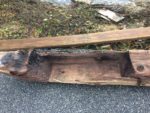 A dugout canoe driven from its watery home on the bottom of the Indian River just north of Cocoa in Brevard County, Florida, by Hurricane Irma has been saved thanks to the quick thinking and responsible actions of a local history buff. Freelance photographer and history enthusiast Randy “Shots” Lathrop spotted a cypress log on the banks of the Indian River on Monday, September 11st. A less keen eye would have dismissed it as just another piece of arboreal debris littering the shores of the river thanks to Irma’s destructive power, but Lathrop noticed its carved interior and prow and recognized it as a dugout canoe.
A dugout canoe driven from its watery home on the bottom of the Indian River just north of Cocoa in Brevard County, Florida, by Hurricane Irma has been saved thanks to the quick thinking and responsible actions of a local history buff. Freelance photographer and history enthusiast Randy “Shots” Lathrop spotted a cypress log on the banks of the Indian River on Monday, September 11st. A less keen eye would have dismissed it as just another piece of arboreal debris littering the shores of the river thanks to Irma’s destructive power, but Lathrop noticed its carved interior and prow and recognized it as a dugout canoe.
He took a picture and sent it to an archaeologist friend who confirmed that it appeared to be a canoe. Lathrop immediately reported the find to the Florida Division of Historical Resources, as required by law, but with all the havoc wreaked by the hurricane the FDHR, the state archaeologist wasn’t going to be able to inspect the canoe right away. Meanwhile, county workers were clearing the area of debris. Lathrop was concerned that they would mistake it for a log, toss it in the truck and put in a landfill before the archaeologist had a chance to see it. He secured permission from the FDHR to move it to safety.
 That was easier said than done, however. The canoe weighs close to 700 pounds, and is saturated with water from having been at the bottom of a river for years or even centuries. He enlisted the aid of a friend with a truck and the two of them managed with difficulty to heft the artifact onto the bed. They transported it to a nearby freshwater pond and submerged it to keep the wood from drying out and to keep hurricane debris collectors from disposing of it.
That was easier said than done, however. The canoe weighs close to 700 pounds, and is saturated with water from having been at the bottom of a river for years or even centuries. He enlisted the aid of a friend with a truck and the two of them managed with difficulty to heft the artifact onto the bed. They transported it to a nearby freshwater pond and submerged it to keep the wood from drying out and to keep hurricane debris collectors from disposing of it.
Three days later, the FDHR dispatched a regional archaeologist from Cape Canaveral Air Force Station to examine the canoe. He wasn’t comfortable identifying its makers or date based solely on the preliminary investigation, but the possibilities are intriguing. This is an unusual piece.
The 15-foot-long canoe could be anywhere from several decades to several hundred years old, according to Sarah Revell, a spokeswoman with the department. Carbon dating will help to narrow down the boat’s age. […]
The canoe has a squared off form, which Revell said is commonly seen in the historic period (from 1513 to about 50 years ago in Florida), but there are several uncommon features on it too: compartments, square nails and what appears to be a seat.
“The compartments are a bit out of the ordinary,” she said. “The square nails are cut nails. Cut nails were first in production in the early 19th century so that helps to indicate it is a historic canoe.”
Lathrop noted that there are visible remains of red and white paint, colors traditionally used by the Seminole people to paint canoes (among other things).
The canoe is now being conserved in a water bath. There are no specific plans for its ultimate disposition at this juncture, but the buzz is it will stay in Brevard County where it will go on public display once it has been stabilized.
Paddle, paddle, paddle y’er beam
Gently, gently down the stream
Merrily, merrily, merrily …
(Indian Trad.)
——————-
In 1987, I saw two blokes in Indonesia with a few axes and chisels digging out a canoe from a tree trunk in an afternoon, but there were no nails at all, not even square ones.
Are the ‘square nails’ those wooden bolts that appear to hold the front seat and the foot block of the back seat in place ? The space in between front and back seat was obviously used for cargo here (or fish?).
:hattip:
First saw the story on our local TV news; thanks for expounding on it and for the Hemingway home post. I dig it!
It truly is an ill wind that blows no good at all. Even when that wind is hurricane strength.
It’s hard to tell what it was used for. Loggers here in the 19th cen. used to make similar dugouts to use to guide rafts of logs down local rivers during high water. There was a name for them, but it escapes me.
Believe it or not, most of that work was done by boys and young men in their teens as a way to escape the little logging towns and nearby farms. When they got to the bigger towns they had stake to hold them over until they found a job, or to buy a railroad ticket out with.
If you look at the bow, the carving and the position of the knot, it looks like a gator head….wonder if this was intentional?